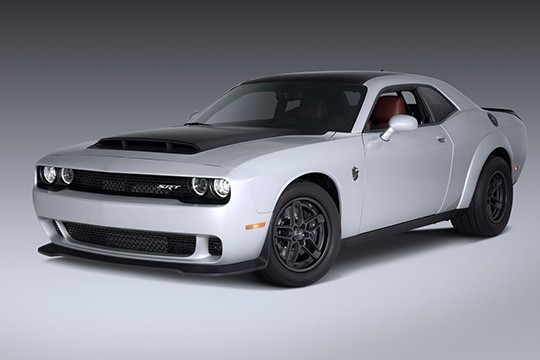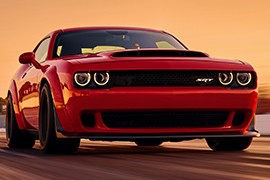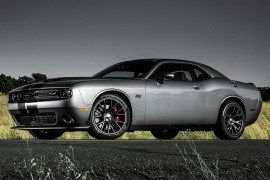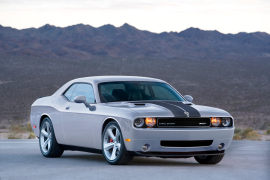DODGE Challenger SRT Models/Series Timeline, Specifications & Photos
First production year: 2009
Engines: Gasoline
Body style: Coupé (two-door)
Dodge made the last call for the Challenger and introduced the SRT Demon 170 in 2023 for those looking for glory on the drag strip with the same car they could drive back home.
In 2023, Dodge created a special edition of the Challenger SRT Demon with more power than a Bugatti Veyron. It was so fast that it had to install a designated port for a parachute to be able to run on official NHRA drag strips, while the regular, non-170 SRT Demon was not. Furthermore, the new version was all business. There are no fancy flared wheel arches at the front, no rear seats, and no no-sense features on the vehicle, apart maybe from the sound system. That was not particularly needed on a car that could complete the quarter-mile run in 8.91-second ET at 151.17 mph (243.3 kph), but it was welcomed when the vehicle was used on public roads. That’s because, despite its outrageous performance, the SRT Demon 170 was street-legal.
While it shared many components with its regular, non-170 brother, the Demon 170 had a few details that made it look apart. At the front, Dodge installed hollow inner lamps. The one on the driver’s side fed air to the massive conic air filter, while the one on the passenger side was there to match the look, albeit some said that it added more fresh air into the engine bay. The hood featured a broad air intake and sported the wording “alcohol injected” as a warning note.
Dodge made a few slight changes to the Challenger Demon 170 compared to the rest of the range. It featured 245/55 Mickey Thompson tires up front wrapped around 18-inch alloy wheels. At the same time, in the back, the automaker adorned the rear fenders with flared wheel arches that covered the 315/50 rubbers on 17-inch wheels. This setup was made by the automaker to enhance performance, not to look awesome in the parking lot. The rear fascia featured a black panel between the rectangular LED taillights, while behind the license plate was the mounting point for a parachute. That’s right, Dodge offered one for those who wanted to outrun any other production car on a drag strip.
The interior looked like a standard Dodge Challenger with a few options on it, but the automaker made some specific changes. Fronting the driver was an instrument cluster fitted with a seven-inch digital information display flanked by the red dials of the tachometer and the speedometer. On the center stack, an additional touchscreen served both for the infotainment unit and to control driving modes, as well as to select other attributes needed on the drag strip. Despite being so potent, the 2023 Challenger RT Demon 170 was not made for track days. It could handle well, but it was not its specialty. And yet, the automaker installed high-bolstered bucket seats for the driver and their side passenger. On the center console, it placed a big handle to deploy the parachute while racing. There were no seats in the back, just a carbon fiber shelf.
Under the hood, Dodge installed the well-known 6.2-liter HEMI engine. It added a three-liter supercharger on top of it, resulting in a 900 hp (912 PS) monster powerplant when it ran on regular E10 fuel. When the special 60% mix of ethanol-gasoline fuel was used, the power went straight up to 1,025 hp (1,039 PS). Thanks to its reinforced eight-speed automatic transmission, the car could accelerate with a face-bending 2.004 g from 0 to 60 mph (0-97 kph) in just 1.66 seconds.
Dodge went full-throttle and let all the wild dreams of its engineers go live when it developed and launched the 2018 Challenger SRT Demon, a car so potent that the NHRA banned it.
Dodge had a long history of creating unusually fast vehicles out of almost anything. It made the Lil’ Red Express pickup in 1979 the fastest American vehicle at that time. It also built the Ram SRT10 in 2004 and transformed it into another go-fast utility vehicle. However, in 2018, Dodge changed the pace and created the 840 hp (852 PS) Challenger SRT Demon, a car that could complete the quarter-mile run in stock form in less than ten seconds. That was enough for the NHRA to ban it from racing since it didn’t feature a parachute, albeit that was offered as an option by the automaker. However, Dodge didn’t just make the coupe go faster than any other Dodge ever made; it also transformed the car’s appearance and provided it with an unusual options list and a rather scarce interior despite its six-figure price.
From the outside, the 2018 Dodge Challenger SRT Demon looked different than its siblings, but only a trained eye could see that. Viewed from the front, it expressed its intentions via the broad black grille and the quad headlights. The aluminum hood featured a wide and slim air intake that helped to cool the engine and was specific for this version of the Challenger. Furthermore, the lower bumper sported an apron with a large center air intake flanked by small side scoops, while it featured a carbon fiber splitter below the spoiler.
From its profile, the widebody kit was one of the elements that characterized the Challenger Demon. A unique badge featuring the contour of a demon adorned the front fenders. The lowered suspension and the standard black alloy wheels made the vehicle look meaner. To complete the aggressive appearance, the automaker installed a retro-styled duck-tail on the trunk lid. Finally, at the back, the Demon had a black rear fascia with wide rectangular taillights and the Dodge lettering between them. Finally, underneath the rear valance, the automaker installed wide pipes to help the engine breathe out.
Inside, the base version of the 2019 Dodge Challenger SRT Demon featured a high-bolstered driver seat and the dashboard. The automaker didn’t install a side-passenger seat or a rear bench in the back, albeit these were available as an option for one USD. These were considered unnecessary while drag-racing, and it was right. On the other hand, the AC unit and the touchscreen for the infotainment system remained in place. The former was needed to cool the air intake, while the latter was useful to provide additional information to the driver.
Under its hood, the 2018 Dodge Challenger SRT Demon featured a 6.1-liter V8 powerplant. It was supercharged and produced a massive 840 hp (852 PS) and a huge 770 lb-ft (1.044 Nm) torque that could shred the rear tire in a split second. All that oomph was sent to the rear axle via an eight-speed automatic transmission and a limited-slip differential.
Dodge introduced a substantial update for the Challenger in 2015, throwing the gloves off and offering a 700+ hp muscle car that could challenge anyone on the drag strip.
While Dodge took the worst time of the decade to launch the Challenger in 2008, during the world financial crisis, its efforts paid off. When the crisis ended a couple of years later, the car was running high tides, and everyone praised it. Then, after a mild update for the 2011 model year, the big American coupe was facelifted for the 2015 model year. This time, it wasn’t just some new wheels and lights on the door handles. It was a leap forward. Besides the exterior, which was slightly updated, the interior went through a complete change. In addition, the drivetrain was refreshed with the introduction of new transmissions, improved engines, and perhaps the most significant upgrade, the Hellcat engine.
Dodge’s engineering team worked in the wind tunnel to enhance the Challenger’s drag coefficient. Its front fascia featured a new vertical-split grille that took its inspiration from the 1971 model. The aluminum hood was adorned by a power-bulge that featured a cold-air intake, which resembled the one installed on the 1996 Dodge Viper coupe. In addition, vehicles fitted with the Hellcat engine had two vents that reduced the heat under the hood. In addition, the supercharged version featured a so-called Air Catcher inlet port that fed air directly into the engine air box through the driver-side parking lamp. Last but not least, the Challenger Hellcat featured a large splitter that increased downforce.
From its profile, the American coupe boasted its muscle-car appearance thanks to its thruster rear fenders, raised behind the doors. Dodge offered the 2015 SRT with 20-inch alloy wheels regardless of the engine version, albeit those fitted on the Hellcat were wider. In addition, the front fenders of that potent version had chromed “Supercharged” badges on the front fenders, like a warning for those who wanted to challenge them. At the back, the automaker dropped the idea of full-width taillights. It installed two separate units with a rectangular shape that resembled those from the 1971 Challenger. Between them, the chromed Dodge badge stood proud on the rear fascia above the bumper. Both versions got a restyled rear valance that made the 2015 Challenger SRT look lower to the ground.
Inside, customers found a completely new interior. Fronting the driver was a fresh instrument panel that showed a seven-inch configurable driver display (DID) flanked by the retro-styled speedometer and tachometer. In addition, the driver fronted a flat-bottom heated steering wheel sporting the SRT badge in the middle. At the same time, the horizontal spokes featured buttons that controlled the media system, the cruise control function, and other functions of the DID. The high-bolstered front seats were leather-wrapped and promised excellent side support during high-speed cornering, while the center console between them was styled differently, depending on the car version. Both had the same trapezoidal shape, but the Challenger SRT 392 featured a “Hectic Mesh” design, while the SRT Hellcat featured a “Dark Engine Turn” finish.
Under the hood, both vehicles came fitted with the 392 HEMI engine that featured on-head valves. The SRT 392 was naturally aspirated, while the SRT Hellcat was helped by a supercharged to develop 707 hp (717 PS). Both versions could be paired with a six-speed manual or an eight-speed automatic transmission that sent all the oomph to the rear wheels.
Dodge sold all the 6,400 units of the 2008 Challenger like hotcakes, and customers who craved one had to wait for the 2009 model year, which came with more engine options and was available at lower prices.
While the world financial crisis started to bite the automotive industry, those in the market for a spectacular-looking coupe had to reconsider their priorities. However, Dodge considered that and provided the 2009 Challenger with more engine options, including a V6. That version, even if it couldn’t keep up with its bigger and more potent brothers, was more affordable. At the same time, some mid-grades had V8s under their hoods, but not as powerful as the mighty 6.1-liter powerplant offered on the 2008 Challenger. A few grades allowed customers to get their hands on one of the most representative retro-styled muscle cars on the market, with or without a V8 under their hoods. In addition, those who wanted a punchy engine to match the vehicle’s look could get one with over 400 ponies to smoke their tires.
With a front fascia that resembled its original 1970 predecessor, the 2009 Dodge Challenger was sure to conquer enthusiasts’ hearts and pockets. Its quad-headlamp design with recessed grille and the available SRT chromed badge (for specific versions) was unique. In addition, the hood featured a pair of vents that flanked the raised center-mounted power dome. The lower bumper could be fitted with a lower chin spoiler and a pair of round fog lamps.
Dodge’s design team took its inspiration from the 1970 model when it penned the Challenger. As a result, the big coupe looked like a pony car made for the twenty-first century but with some traditional cues. For instance, the long hood, low-slung greenhouse, and step-up rear fenders were classic lines for such a vehicle. Furthermore, Dodge installed an exposed gas-filler cap on the left quarter panel. The flush door handles and body-colored mirror caps added flavor to the revived Challenger. At the back, the full-width taillights sported the carmaker’s name in the middle, while an available retro-styled spoiler adorned the trunk’s lid.
Inside, all versions featured an instrument panel with four individual clusters for the speedometer and tachometer in the middle, flanked by the fuel level and the temperature gauges. The center stack housed the infotainment unit and the HVAC controls. At the same time, Dodge installed the gear stick or the gear selector (depending on the options) on the center console between the front occupants. In the back, the bench seat could accommodate three people on short jaunts, albeit it was profiled for two. Legroom and headroom were not impressive but adequate for adults.
The 2009 Challenger shared its platform with the 2006 Dodge Charger. It featured unequal-length arms for the front independent suspension and a five-link system for the rear axle. Thanks to this setup, the revived pony car was way more comfortable than its illustrious ancestor. A 3.6-liter V6 opened the list for the 2009 Challenger, while at the other end of the scale was a 6.4-liter Hemi engine. There were two transmission options: a six-speed manual or a five-speed automatic with manual override.



